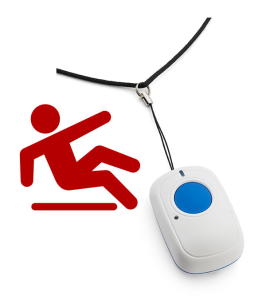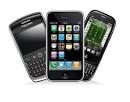 Med-Alert Systems: Important Features for People with ALS
Med-Alert Systems: Important Features for People with ALS
By: Amy Roman, MS, CCC-SLP
Many people with ALS require some type of alerting system to gain the attention of caregivers. In my last article, Alerting Systems For The Home, I described various systems to alert a caregiver within the house when you have a need or emergency. Now we will look at Med-Alert systems that reach outside the home to let your family, friends or even a local emergency response team know when you need help.
These systems known also as Personal Emergency Response Systems (PERS) send out an alert even if you can’t speak or get to a phone. By pressing a button, an emergency call is placed typically through your landline phone. This button can be worn on a wrist band, around your neck, on a belt clip or placed in rooms. Some are adapted for people with virtually no movement. Monitored PERS connect you to a person at a response center. Response personnel have access to your address, medical information and your emergency contact phone numbers.
If you are able to speak, and within voice range, you can talk to this individual who will find out what kind of help you need and contact the appropriate people or emergency teams.
If you are unable to speak or too far from a monitor, the operator will follow a protocol that you have pre-arranged. This protocol lists who is to be called and in what order. Your instructions can indicate that you want your spouse, family members and neighbors to be called first and only if they don’t respond should a call go to 911.
These monitored PERS typically charge a monthly fee of between $30 and $40. Reputable companies will provide you with pricing over the phone and not require a home visit/sales pitch.
Special Options and Features You May Need
Cellular
Cell phone options are becoming more readily available from companies like MobileHelp and Medical Alert. This is important for the increasing number of people who no longer maintain landline service as well as for people who want to take their PERS on the road.
Switch Adapted
If you can’t press a button, you may require a switch adapted PERS. These are offered though Phillips Lifeline, ASA Automated Security Alert, VRI Medical Alert, Carelink and other services. Since fewer people utilize these switch adapted options, you may need to guide a customer service representative to the webpages provided here to help them find these offerings within their company. For a review of switches that allow a person with very limited movement to activate a PERS see My Top 5 Switches for pALS and Alerting Systems for the Home. An occupational therapist, assistive technology specialists or speech therapist can provide you with an assessment to identify the best switch for you and a location for the switch which is accessible but unlikely to cause accidental activations.
Fall Detection 
If you are ambulatory you will also want a system that offers fall detection. This feature provides peace of mind in the event that a fall results in a loss of consciousness or an injury that makes activating the Med-Alert impossible. Phillips and Mobile Help offer or have announced plans to offer this option.
If falls are a concern, keep in mind that many falls happen in the night on the way to the bathroom. Be sure to have your PERS or cell phone with you during this and all other walks no matter how short. A cell phone can be slipped into a bathrobe pocket and a PERS should be on at all times. Most PERS are water proof so they can go into the shower which is a high slip risk area. The ability to wear your lifeline in the shower is a very significant advantage of PERS over using one’s cell phone as your only connection to the outside world.
Non-Monitored PERS
I highly recommend “monitored” PERS, like those discussed above, over “non-monitored” if they are within your budget.
Non-monitored PERS like Guardian Alert, include a wearable button and a special phone that automatically dials your stored contact numbers in a specified order. If the first person does not answer, it will call the next person in your sequence and so on. The last number is typically an emergency number like 911. No monthly service fee is required since a call center is not provided. The phone and pendant package typically cost between $100-$300.
While I have had a few clients who reported success with these systems I have also heard countless complaints about their lack of reliability and difficulty with set up.
For additional information comparing PERS, I recommend the Consumer Report Article Comparing Med-Alert Systems.
Cell Phones and 911 
Many people think they will use a cell phone in an emergency but mobile phones unlike landlines, don’t provide your address or name to an emergency dispatcher during a 911 call. I highly recommend you set up a free Smart911 Safety Profile if you have any speech difficulties. Your Smart911 profile will then appear at the emergency call center with the information you have provided including your home location and other facts needed to get help quickly to you. Unfortunately, not all areas offer Smart911 yet. To check availability of Smart911 in your area and register your profile, go to: https://safety.smart911.com/smart911/#.Vagm6TjbLcs



Hello Amy,
My mom is going into her 5th years of ALS. She is totally bed ridden and unable to make any movement except her eyes and when she has her painful muscle spasm. I have been trying to find something we can communicate with her. We are Chinese and Cantonese speaking. Are you aware of any eye movement device that can write in strokes(Chinese writing) then speak in Cantonese? I know I can download the voice software but not sure about the device that write Chinese.
It will be great help for my mom if I can find this device.
Thank you for your help.
Hi,
Currently the Grid2 (not Grid 3)and Communicator do offer Chinese communication options (as of April of 2017) Grid is made by Smart Box and available on a wide variety of speech generating devices that offer eye tracking. Communicator is made by Tobii and they too have eye tracking options for your mom.
You will need to find a speech therapist who is familiar with augmentative alternative communication (AAC). This speech therapist will provide your mom with trials with different communication devices that can meet her language and alternative access (eye tracking or scanning) needs and submit the medical documentation to have the device covered through insurance. Contact your local ALS Association or MDA for a referral to a qualified speech therapist.
Take a look at my Pinterest site for some more ideas including a low-tech, 2 stroke method for communicating in Mandarin. https://www.pinterest.com/amyandpals/text-to-speech-in-asian-languages/
Thank you for sharing and I hope my suggestions were helpful.
Amy
Hi. My dad is a quadriplegic & basically bedridden with muscle atrophy due to a spinal cord injury.
Do you know of any voice activated medical alert companies?
Thank you!